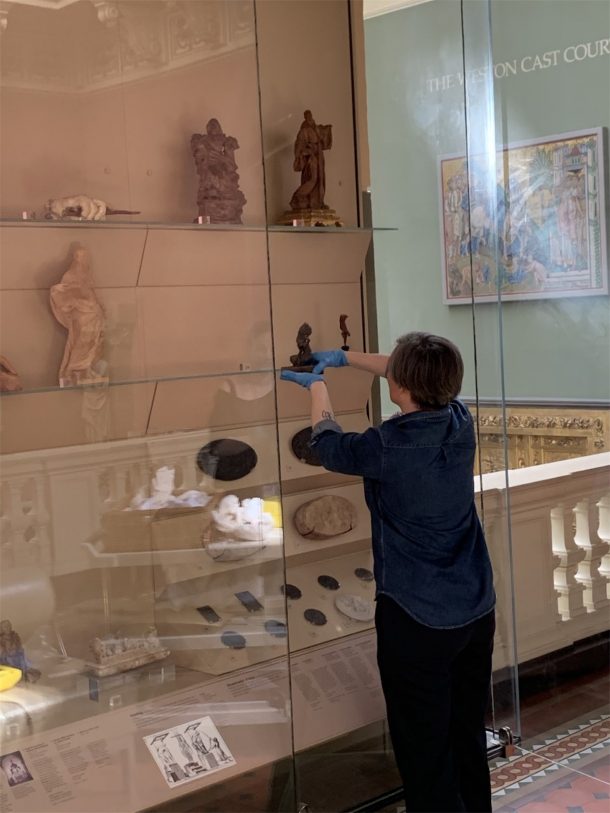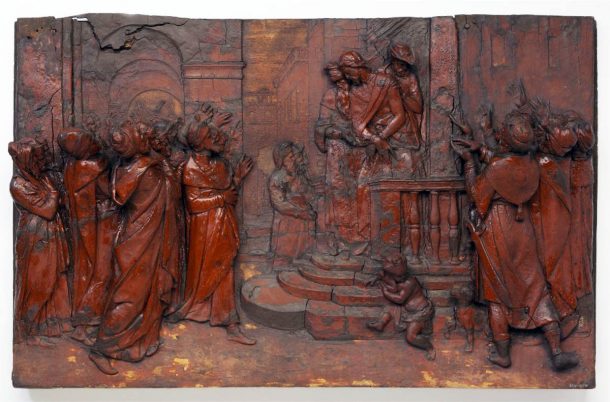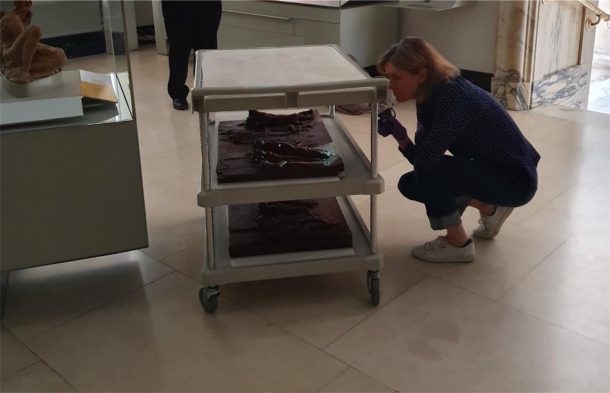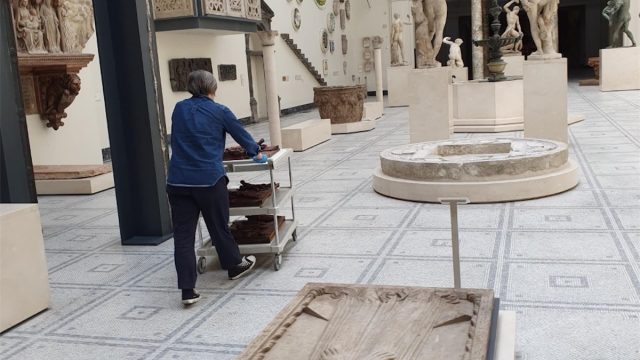As the COVID-19 pandemic hit the UK and the country entered lockdown, like other museums the V&A soon had to close its doors to staff and visitors. Since 20 March, the South Kensington site has only been accessed by a few: the Security team (you may have followed Vernon Rapley’s wanderings through the Museum on Twitter) and those carrying out essential building work. But this does not mean that Curators and Conservators, under whom the care of objects befalls, have not been keeping an eye on the collections.
We have been following how they are doing from afar, yet in real time. The Security team have become our eyes, paying close attention to the objects on their daily walks, informing us of any concerns they have. Many of the normal risks for museum objects are lower in lockdown: without visitors and contractors, and so few staff on-site, there is less risk from vibration, of dust, or of objects getting touched by accident. We still have to worry about moths and other insects, and so regular checks of bug traps still take place. It’s crucial to keep an eye on environmental conditions, too. The Museum’s trusty environmental sensors are at work 24/7, dotted around the building to monitor relative humidity and temperature in the 145 galleries at South Kensington, some of them placed inside the display cases of particularly vulnerable objects.
And so we have been observing this spring’s rise in temperatures closely, as some objects, such as wax reliefs and figures, can be sensitive to heat. As the temperature warms up outside, so does the Museum, and by comparing data from previous years, combined with this year’s record monthly temperatures, it has become obvious that a hot summer is fast approaching.

With temperatures reaching a 25 – 27C range in May, our inner alarm bells started ringing, and we knew some objects would need moving into our cooler storage facilities sooner rather than later.
Thankfully, not all wax objects have to be moved to the stores when the temperature goes up! Some are more vulnerable than others, whether because of their position in the galleries, or their specific composition. The five that caused us concerns were preparatory pieces by Giovanni da Bologna (1529 – 1608), better known as Giambologna. Hailing from Flanders, he moved to Rome in 1550 before working at the Medici court in Florence. By the late 16th century, he had become the most influential sculptor in Europe.
Wax models offer valuable insights into an artist’s working process. Like drawings, they are an important interim stage in the making of sculpture. They are produced for immediate reference by the artist and not intended to last. The fragility of wax as a medium makes the physical survival of the V&A’s pieces even more remarkable, suggesting they were especially valued and consequently well cared for during the 400 years since they were made. Drawings associated with high-profile artists were already considered collectable in the 16th century, and it is likely that wax sketches were also gaining the same importance.
By initially working quickly with wax, Giambologna was able to use the malleable qualities of the medium to create models that appear spontaneous and fluid. The small female nude ascribed to him displays the sensuous fluidity of form and movement typical of the artist, while the sketch for Hercules and the Centaur focuses on the tension between the irresistible strength of Hercules and the contorted figure of his enemy, soon to be overcome.

The reliefs of Christ before Pilate, Ecce Homo, Pilate washing his hands and Christ led from Judgement are the studies for three of the six bronze scenes of the Passion that Giambologna made around 1579 – 80 for the Grimaldi Chapel, in San Francesco di Castelletto, Genoa. No original drawings for these have survived, making the wax models even more important. The exquisite virtuosity in the modelling of the figures (their very high relief makes the panels particularly nerve-wracking to move!) and the dynamism of the composition in wax explains how the finished bronzes became so celebrated. Two further versions of the panels were cast in bronze, with small modifications: one for Giambologna’s memorial chapel in the Annunziata in Florence, while the third set is in the Bayerisches Nationalmuseum, Munich.

The condition of the three panels has proved of interest (and concern) to conservators over the years due to the visible changes that occur to the surface as the conditions in the surrounding environment changes. This varies from some areas developing a distinctly shiny oily appearance, while at other times the surface can exhibit a fine white powdery salt deposit. Analysis of a sample from one of the panels, carried out by the National Gallery in the late 1970s, identified the type of wax as mainly beeswax – with some fat or tallow additives. A small amount of resin was found, confirmed as Venice turpentine mixed with colophony (pine resin). The tallow was presumably added to improve the modelling properties of the wax. Unfortunately, the fat has partially broken down with age, producing fatty acids and glycerol at the surface. It’s not at all clear why this happens, but it has been suggested that it might be due to microbial action, explaining the sticky droplets.

When temperatures reach a concerning level, we have to balance the risk inherent in moving delicate objects across the Museum into storage against the consequences of doing nothing. For the Giambologna reliefs, a rescue operation was in order. Having switched to working from home in mid-March, we knew that only exceptional circumstances would call us back on site until lockdown properly lifts. There is a system in place for emergencies – from ‘salvage kits’ to the obligatory COVID-19 ‘Risk Assessment / Method Statement’ process; these are clearly set out to ensure that social distancing and risk-mitigating measures are in place. Curators have the day-in, day-out experience of moving objects from case to storage, yet doing so when the Museum is empty of staff and visitors felt markedly different.

The step-by-step approach was the same as ever, from collecting keys to opening cases and gently lifting the objects off their shelves on to a trolley. But being there under lockdown was one of the strangest Museum experiences we have encountered. As Museum staff we have strong emotional ties to ‘our’ objects and ‘our’ spaces. They feel like old friends, and like home. Areas that we are accustomed to seeing thronged with visitors are now deserted, our footsteps echoing though the V&A’s halls. It looks as though the objects are resting or sleeping, ready to come alive again once visitors can return. Or perhaps they are enjoying conversing with each other without people eaves-dropping on them? Gingerly wheeling a trolley laden with the precious rescued waxes through the Victorian tunnels deep beneath the Museum to the stores felt post-apocalyptic – is there still a world to return to outside? Re-emerging into the sunny streets of London felt both strange and sad. Time had stood still in the Museum’s quiet galleries and vaults. Leaving our missed silent ‘friends’, we knew we would not be back for a good while.
This post was written jointly by Victoria Oakley (Objects Conservation Section Leader) Ella Ravilious (Curator: Documentation and Digitisation), Bhavesh Shah (Scientist (Environment)) and Melanie Vandenbrouck (Sculpture Curator)


